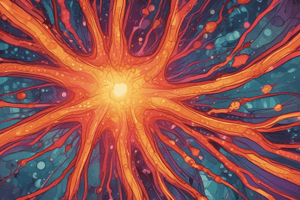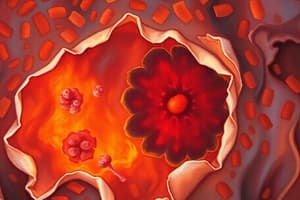Podcast
Questions and Answers
What is the result of the accumulation of lactic acid in anaerobic glycolysis?
What is the result of the accumulation of lactic acid in anaerobic glycolysis?
- Increased pH
- Decreased/more acidic pH (correct)
- Increased cell volume regulation
- No change in pH
What is homeostasis?
What is homeostasis?
- A type of feedback mechanism
- A state of instability in the body
- A type of cell injury
- A dynamic, steady state of achieving internal balance (correct)
Oxygen and oxygen-derived free radicals are effectors of cell injury.
Oxygen and oxygen-derived free radicals are effectors of cell injury.
True (A)
Ischemia is a type of reversible cell injury.
Ischemia is a type of reversible cell injury.
What is the difference between non-specific and specific immune responses?
What is the difference between non-specific and specific immune responses?
What are the three components of a feedback mechanism?
What are the three components of a feedback mechanism?
The vascular response causes ___________, which increases vascular permeability and allows WBCs to migrate to the site of injury.
The vascular response causes ___________, which increases vascular permeability and allows WBCs to migrate to the site of injury.
When homeostasis is disrupted, it can lead to _______________________.
When homeostasis is disrupted, it can lead to _______________________.
Match the following components of the vascular response with their effects:
Match the following components of the vascular response with their effects:
Match the following terms with their definitions:
Match the following terms with their definitions:
What is the result of the impairment of cell volume regulation in anaerobic glycolysis?
What is the result of the impairment of cell volume regulation in anaerobic glycolysis?
The adaptive immune system is the first line of defense against infection.
The adaptive immune system is the first line of defense against infection.
What is the main cause of irreversible cell injury?
What is the main cause of irreversible cell injury?
Positive feedback mechanisms work to restore homeostasis.
Positive feedback mechanisms work to restore homeostasis.
What is the ultimate goal of the vascular response in inflammation?
What is the ultimate goal of the vascular response in inflammation?
What is the result of cellular swelling?
What is the result of cellular swelling?
Which component of the vascular response is responsible for the initial recruitment of white blood cells to the site of injury?
Which component of the vascular response is responsible for the initial recruitment of white blood cells to the site of injury?
Chemotaxis refers to the movement of cells in response to mechanical stimuli.
Chemotaxis refers to the movement of cells in response to mechanical stimuli.
What is the role of the clotting cascade in response to inflammation?
What is the role of the clotting cascade in response to inflammation?
The process of marking pathogens for phagocytosis is known as _______.
The process of marking pathogens for phagocytosis is known as _______.
Match the following components to their functions in inflammation:
Match the following components to their functions in inflammation:
Which of the following best describes chemotaxis?
Which of the following best describes chemotaxis?
Mast cells play a role in increasing vascular permeability during inflammation.
Mast cells play a role in increasing vascular permeability during inflammation.
Name one type of cytokine involved in the inflammatory response.
Name one type of cytokine involved in the inflammatory response.
Which of the following is NOT a common cause of edema?
Which of the following is NOT a common cause of edema?
Is hypernatremia characterized by sodium levels greater than 145 mEq/L?
Is hypernatremia characterized by sodium levels greater than 145 mEq/L?
List one of the modifiable risk factors for coronary heart disease.
List one of the modifiable risk factors for coronary heart disease.
The condition resulting from injury to the endothelium leading to inflammation is called __________.
The condition resulting from injury to the endothelium leading to inflammation is called __________.
Match the following shock types with their descriptions:
Match the following shock types with their descriptions:
What is the primary factor involved in developing atherosclerotic plaques?
What is the primary factor involved in developing atherosclerotic plaques?
Older age is a modifiable risk factor for coronary heart disease.
Older age is a modifiable risk factor for coronary heart disease.
What complication does pulmonary edema fall under?
What complication does pulmonary edema fall under?
Which of the following leukocytes are primarily responsible for fighting off parasitic infections?
Which of the following leukocytes are primarily responsible for fighting off parasitic infections?
Osmosis is an active process that requires energy expenditure to move water molecules across a membrane.
Osmosis is an active process that requires energy expenditure to move water molecules across a membrane.
What is the primary role of mast cells in the inflammatory response?
What is the primary role of mast cells in the inflammatory response?
Dendritic cells act as messengers between the ______ and ______ immune systems.
Dendritic cells act as messengers between the ______ and ______ immune systems.
Match the following leukocytes with their primary functions:
Match the following leukocytes with their primary functions:
Which of the following is NOT a type of shock?
Which of the following is NOT a type of shock?
What is the main characteristic that distinguishes cardiogenic shock from other types of shock?
What is the main characteristic that distinguishes cardiogenic shock from other types of shock?
Neurogenic shock is characterized by a sudden loss of blood pressure due to an overactive sympathetic nervous system.
Neurogenic shock is characterized by a sudden loss of blood pressure due to an overactive sympathetic nervous system.
Flashcards are hidden until you start studying
Study Notes
Inflammatory Response
- Vasodilation increases microvascular permeability, allowing neutrophils to migrate and activating pain receptors.
- Bradykinin is the primary kinin produced during inflammation.
- Mast cells release histamine and mediate the inflammatory response.
- Dendritic cells process and present antigens to activate T-cells, acting as messengers between the innate and adaptive immune systems.
- Leukocytes include:
- Neutrophils (60-70% of WBCs): Key players in phagocytosis.
- Eosinophils: Combat allergies and parasites; associated with asthma.
- Basophils: Involved in inflammatory and hypersensitivity reactions.
- Monocytes/Macrophages: Differentiate into tissue macrophages for phagocytosis.
- Natural Killer (NK) Cells: Target virus-infected and cancer cells.
- B-Cells: Produce antibodies.
- T-Cells: Fight infections and enhance immune response.
Fluid and Electrolyte Balance
- Osmosis: Passive process moving water from high to low concentration across a semi-permeable membrane, requiring no energy.
- Hydrostatic pressure: The force exerted by fluids in a system; differs from osmosis in that it can involve energy.
- Lactic acid accumulation in anaerobic glycolysis leads to decreased pH, disrupting Na+/K+ pump function and causing cell swelling.
Altered Cell Function
- Hypoxic cell injury: Decrease in oxygen delivery to blood cells, often due to lung injury; ischemia is the primary cause of cell injury.
- Irreversible cell injury can result from cell membrane damage and lysosomal membrane injury leading to enzyme leakage and necrosis.
- Fluid loss from blood vessels leads to cellular swelling, signaling compromised cell viability.
Immune Response
- Non-specific (innate immunity) includes inflammation and natural barriers; specific (adaptive immunity) involves humoral (B-lymphocytes) and cell-mediated (T-lymphocytes) responses.
- Vascular response entails vasodilation and increased permeability, facilitating white blood cell migration to injury sites for healing, infection prevention, and damage control.
Feedback Mechanisms in Homeostasis
- Homeostasis is a dynamic state of internal balance; disruptions can cause illness.
- Maintained by feedback mechanisms with three components:
- Sensor: Detects changes.
- Control Center: Regulates responses.
- Effector: Restores balance.
- Two types of feedback mechanisms:
- Negative: Corrects disruptions (e.g., regulating blood glucose).
- Positive: Further accentuates changes (e.g., labor contractions).
Plasma Protein Cascade and Chemotaxis
- Plasma protein cascade includes the complement system, clotting cascade, and kinin system.
- Chemotaxis refers to the movement of cells in response to chemical stimuli, often driven by cytokines.
- Complement system: Recruits WBCs to injuries and facilitates destruction of pathogens through lysis and opsonization.
- Clotting cascade forms a meshwork that traps microorganisms, promotes healing, and halts bleeding.
Sodium and Water Balance Alterations
- Isotonic alterations involve equal concentration changes in body water and electrolytes.
- Hypertonic alterations result in intracellular dehydration with Na+ >145, causing fluid to move out of cells.
- Hypotonic alterations present with Na+ <135, indicating excess water and low extracellular osmolarity.
Risk Factors for Coronary Heart Disease
- Modifiable: Hyperhomocysteinemia, dyslipidemia, hypertension, smoking, obesity, diabetes, sedentary lifestyle, stress, alcohol use.
- Non-modifiable: Age, gender (higher risk for males and post-menopausal females), genetic predisposition, ethnicity (higher among Black/Asian populations).
Atherosclerotic Plaque Development
- Initiating event: Injury to the endothelium leads to dysfunction and inflammation.
Studying That Suits You
Use AI to generate personalized quizzes and flashcards to suit your learning preferences.




